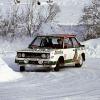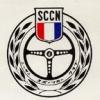
1976 - Fuji and Kojima
#1

Posted 10 October 2002 - 12:43
The race saw four local entries of which three were unremarkable - Noritake Takahara (Surtees), Masami Kuwashima (Wolf-Williams) and Kazuyoshi Hoshino (Tyrell) – but the fourth made people sit up and take notice. Masahiro Hasemi, driving the Japanese designed and built Kojima-Ford KE007, set 4th fastest time in the first qualifying session. Despite a crash that ruled him out of the rest of qualifying, he was still able to take 10th spot on the grid. Although a wet start and then a drying race track meant that he was caught on the wrong tyres, and could only finish last, he did manage to take the fastest lap. Then the car was never seen again in F1.
So what do we know about this car, the team and the clearly pretty talented driver? Even allowing for home track advantage, how could an inexperienced constructor manage to field a car that was so competitive with the F1 big guns on its first (and only) outing? They used Japanese Dunlops, which were reckoned to be part of their advantage, but how did Dunlop manage to make tyres that good, when they weren’t even in F1 otherwise?
Kojima turned out two KE009 cars for the 1977 race, qualifying 11th (Hoshino) and 19th (Takahara) and coming 11th and DNF respectively. The team was never seen again AFAIK. Who was behind it? Why did they not do more races – clearly the potential was there?
Can any of our historians cast some light on this F1 blind-alley?
Advertisement
#2

Posted 10 October 2002 - 13:18
I believe Arturo Merzario was interesting in buying the Kojima but developed the Merzario instead...
#3

Posted 10 October 2002 - 15:31
The Marlboro Grand Prix Guide suggests this belongs to Laffite.Originally posted by ensign14
There was a recent Motor Sport article suggesting that the organizers boobed over the fastest lap, which should have gone to Jacques Laffite, but by the time the records were corrected the press had given it to Hoshino.
OK, let's see the latter!I believe Arturo Merzario was interesting in buying the Kojima but developed the Merzario instead...
There's something about that in either Mr Nye's Autocourse GP Car book or in Hodges'A-Z (probably both).
Not much though...In the secong half of the 1970s Kojima engeneering of Kyoto seemed poised to become a force in single-seater racing with F1 cars that were not disgraced into their two races and F2 races that performed creditably in Japanese racing, by no means a domestic affair as by then the F2 series was contested by leading European drivers and cars.
Matsuhisa Kojima had involved his company in racing through a decade in national categories and in F2 with March chassis. The F1 cars in 1976-77 were straighforward and competent - lessons had been learned from the Maki fiasco - but despite the proclaimed intentions the were not run outside Japan and that was no basis for a racing programme. The in-house F2effort carried Kojima through to the end of the decade as a constructor, but led nowhere.
#4

Posted 10 October 2002 - 16:22
The sources that I have seen credit it to Hasemi (not Hoshino!) on lap 25 with a time of 1.18.23.Originally posted by Geza Sury
The Marlboro Grand Prix Guide suggests this belongs to Laffite
#5

Posted 10 October 2002 - 16:23
Originally posted by ensign14
I believe Arturo Merzario was interesting in buying the Kojima but developed the Merzario instead...There's something about that in either Mr Nye's Autocourse GP Car book or in Hodges'A-Z (probably both).
I thought it was Willi Kauhsen was wanted to buy the Kojimas - then went off to build his own utter shed instead!
"Little Art"'s first F1 car under his own name was a March 7[456 - take your pick!]1 turned into a wing car by Simon Hadfield. Fortunately Simon recovered and now is an ace driver and restorer of historics ;)
After that, he bought the Kauhsen stuff - Christ knows why, it was diabolical in the hands of Brancatelli!
Eventually, he saw sense and stepped down to F2, but made it clear that his car would take a DFV if necessary. Perhaps fortunately, it wasn't necessary ;)
#6

Posted 10 October 2002 - 16:25
Pete, Arturo ended up buying the Kauhsen (aka the Merzario A4? - Allen, help me!) - have I completely got this the wrong way round? That's posting from work for you...
#7

Posted 10 October 2002 - 16:28
Originally posted by ensign14
Hasemi, sorry, brain fade again. Never could get the hang of Thursdays.
Pete, Arturo ended up buying the Kauhsen (aka the Merzario A4? - Allen, help me!) - have I completely got this the wrong way round? That's posting from work for you...
Yes - I was editing my post to put that in as you were replying - one of those chains of thought that started with the Kojima via the Kauhsen, then it rung a Little Art bell in my head.
Kauhsen also bought the '76 F2-championship-winning Elf 2Js, modified them, and achieved nothing at all with them in '77. What a guy ;)
pete
#8

Posted 10 October 2002 - 17:13
Allen
#9

Posted 10 October 2002 - 20:49
#10

Posted 10 October 2002 - 21:10
#11

Posted 11 October 2002 - 09:15
On a side issue, how good was Hasemi? Obviously he was on a home track before a home audience, but you can't help thinking that had a European driver performed this well on his F1 debut, he would have been snapped up pronto by one of the teams. Yet Hasemi never did another GP although he did win the Daytona 24 Hrs some years later.
#12

Posted 11 October 2002 - 09:57
#13

Posted 11 October 2002 - 10:34
Originally posted by ghinzani
How did Willibold come to acquire a Kojima ? In that brilliant race cars since 1945 they mention a rumor of Honda engines for 78 - would this have been what became the Judd/Mugen BV F3000 mills?
On the same theme, at the same time as the Kojima-Honda rumours I vaguely recall rumours that Kojima or Heros Racing were going to buy Surtees or Shadows for a full season in '78.... what became of that?
(well, we know what became of it - but how and why did it fail!)
pete
#14

Posted 11 July 2010 - 21:40
So has anyone got any views on how Kojima could just pop and be on the pace of the regular F1 teams? Or why Japanese Dunlop could be so competitive when that company wasn't normally competing in F1? And why, given such a good showing, the team simply put the car away again until the next Japanese GP, instead of plunging in fully?
On a side issue, how good was Hasemi? Obviously he was on a home track before a home audience, but you can't help thinking that had a European driver performed this well on his F1 debut, he would have been snapped up pronto by one of the teams. Yet Hasemi never did another GP although he did win the Daytona 24 Hrs some years later.
I think a lot of the pace was the local tyres, especially in the wet
#15

Posted 29 December 2022 - 20:29
Exactly what happened to Hasemi during the race? I presume the great advantage the Japanese had were their wet tyres. Kojima used Dunlops, but they didn't have slick tyres or equipment to change them, on a period where scheduled tyre changes were rare, if nonexistent?
#16

Posted 30 December 2022 - 13:21
The race saw four local entries of which three were unremarkable - Noritake Takahara (Surtees), Masami Kuwashima (Wolf-Williams) and Kazuyoshi Hoshino (Tyrell)
A mere 20 years later I would add that in my view Hoshino's entry did become somewhat remarkable when he passed Regazzoni's factory Ferrari in his old private Tyrrell for third place...
#17

Posted 31 December 2022 - 14:36
Exactly what happened to Hasemi during the race? I presume the great advantage the Japanese had were their wet tyres. Kojima used Dunlops, but they didn't have slick tyres or equipment to change them, on a period where scheduled tyre changes were rare, if nonexistent?
How about the possibility that Hasemi's performance reflected the fact that he had thousands of laps around Fuji Speedway - in all conditions - under his belt, had been an instructor at the Nissan Racing School based at the circuit, had driven all sorts of machinery there and was - this apparently a surprise to non-Japanese observers - not a Tugger...?
The Kojima KE007 was, all things considered, a fairly decent car and the Dunlop Japan wets were a known quantity at Fuji for the Japanese drivers. Dunlop Japan had done a lot of their own development. The Kojima team did have slicks, just not enough of them.
There's always the faint sniff of underestimation in topics like these. The contemporary reports reflect it, I think. Look at that "led nowhere" quote from Autocourse. There never seems to be any consideration of what the Japanese teams, constructors, drivers and all concerned might have got out of their efforts on their own terms, what it meant to them in their local activities, what it meant for domestic motorsport in Japan, even what it meant for Japan as a nation. It meant a lot, I'd say.
#18

Posted 31 December 2022 - 15:32
How about the possibility that Hasemi's performance reflected the fact that he had thousands of laps around Fuji Speedway - in all conditions - under his belt, had been an instructor at the Nissan Racing School based at the circuit, had driven all sorts of machinery there and was - this apparently a surprise to non-Japanese observers - not a Tugger...?
The Kojima KE007 was, all things considered, a fairly decent car and the Dunlop Japan wets were a known quantity at Fuji for the Japanese drivers. Dunlop Japan had done a lot of their own development. The Kojima team did have slicks, just not enough of them.
There's always the faint sniff of underestimation in topics like these. The contemporary reports reflect it, I think. Look at that "led nowhere" quote from Autocourse. There never seems to be any consideration of what the Japanese teams, constructors, drivers and all concerned might have got out of their efforts on their own terms, what it meant to them in their local activities, what it meant for domestic motorsport in Japan, even what it meant for Japan as a nation. It meant a lot, I'd say.
Yes, I am aware all those Japanese drivers were great drivers at home and extremely experienced.
My main concern were the tyres.
















